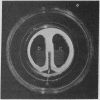Abstract
A three-chamber culture system was devised in which neurites growing from small clusters of somas of sympathetic neurons penetrated a virtually fluid-impermeable barrier; thus the local fluid environment of the distal portions of the neurites could be controlled independently of the local fluid environment of the somas and proximal portions of the neurites. Neurites regularly penetrated the barriers if a high concentration of nerve growth factor was present on both sides, but never penetrated into chambers to which no nerve growth factor had been added.
After neurites crossed the barrier, local removal of nerve growth factor from the distal portions of the neurites caused the growth of these portions to stop, and they eventually appeared to degenerate even though nerve growth factor was continuously present in the chamber that contained their somas and proximal portions. In contrast, local nerve growth factor was not required at the somas and proximal portions of the neurites; many neurons survived its withdrawal provided their somas were associated with neurite bundles that crossed into a chamber containing nerve growth factor.
These results show that the growth, and probably the survival, of neurites depends upon nerve growth factor in their local environment, regardless of the nerve growth factor concentrations to which other portions of the neuron are exposed. This is entirely consistent with the notion that nerve growth factor released by sympathetic target tissues promotes the establishment and maintenance of appropriate neuron-target connections during development.
Keywords: chemotaxis, culture methods, retrograde transport, sympathetic ganglia
Full text
PDF



Images in this article
Selected References
These references are in PubMed. This may not be the complete list of references from this article.
- Chamley J. H., Campbell G. R., Burnstock G. An analysis of the interactions between sympathetic nerve fibers and smooth muscle cells in tissue culture. Dev Biol. 1973 Aug;33(2):344–361. doi: 10.1016/0012-1606(73)90142-5. [DOI] [PubMed] [Google Scholar]
- Chamley J. H., Dowel J. J. Specificity of nerve fibre 'attraction' to autonomic effector organs in tissue culture. Exp Cell Res. 1975 Jan;90(1):1–7. doi: 10.1016/0014-4827(75)90349-3. [DOI] [PubMed] [Google Scholar]
- Ebendal T., Jacobson C. O. Tissue explants affecting extension and orientation of axons in cultured chick embryo ganglia. Exp Cell Res. 1977 Mar 15;105(2):379–387. doi: 10.1016/0014-4827(77)90135-5. [DOI] [PubMed] [Google Scholar]
- Hendry I. A., Stöckel K., Thoenen H., Iversen L. L. The retrograde axonal transport of nerve growth factor. Brain Res. 1974 Mar 15;68(1):103–121. doi: 10.1016/0006-8993(74)90536-8. [DOI] [PubMed] [Google Scholar]
- Hendry I. A. The response of adrenergic neurones to axotomy and nerve growth factor. Brain Res. 1975 Aug 22;94(1):87–97. doi: 10.1016/0006-8993(75)90879-3. [DOI] [PubMed] [Google Scholar]
- Johnson D. G., Silberstein S. D., Hanbauer I., Kopin I. J. The role of nerve growth factor in the ramification of sympathetic nerve fibres into the rat iris in organ culture. J Neurochem. 1972 Sep;19(9):2025–2029. doi: 10.1111/j.1471-4159.1972.tb05112.x. [DOI] [PubMed] [Google Scholar]
- LEVI-MONTALCINI R., ANGELETTI P. U. Essential role of the nerve growth factor in the survival and maintenance of dissociated sensory and sympathetic embryonic nerve cells in vitro. Dev Biol. 1963 Mar;6:653–659. doi: 10.1016/0012-1606(63)90149-0. [DOI] [PubMed] [Google Scholar]
- Letourneau P. C. Cell-to-substratum adhesion and guidance of axonal elongation. Dev Biol. 1975 May;44(1):92–101. doi: 10.1016/0012-1606(75)90379-6. [DOI] [PubMed] [Google Scholar]
- Levi-Montalcini R., Booker B. DESTRUCTION OF THE SYMPATHETIC GANGLIA IN MAMMALS BY AN ANTISERUM TO A NERVE-GROWTH PROTEIN. Proc Natl Acad Sci U S A. 1960 Mar;46(3):384–391. doi: 10.1073/pnas.46.3.384. [DOI] [PMC free article] [PubMed] [Google Scholar]
- Levi-Montalcini R., Booker B. EXCESSIVE GROWTH OF THE SYMPATHETIC GANGLIA EVOKED BY A PROTEIN ISOLATED FROM MOUSE SALIVARY GLANDS. Proc Natl Acad Sci U S A. 1960 Mar;46(3):373–384. doi: 10.1073/pnas.46.3.373. [DOI] [PMC free article] [PubMed] [Google Scholar]
- Levi-Montalcini R. The nerve growth factor: its role in growth, differentiation and function of the sympathetic adrenergic neuron. Prog Brain Res. 1976;45:235–258. doi: 10.1016/S0079-6123(08)60993-0. [DOI] [PubMed] [Google Scholar]
- Mains R. E., Patterson P. H. Primary cultures of dissociated sympathetic neurons. I. Establishment of long-term growth in culture and studies of differentiated properties. J Cell Biol. 1973 Nov;59(2 Pt 1):329–345. doi: 10.1083/jcb.59.2.329. [DOI] [PMC free article] [PubMed] [Google Scholar]
- Patterson P. H., Chun L. L. The induction of acetylcholine synthesis in primary cultures of dissociated rat sympathetic neurons. I. Effects of conditioned medium. Dev Biol. 1977 Apr;56(2):263–280. doi: 10.1016/0012-1606(77)90269-x. [DOI] [PubMed] [Google Scholar]
- Stöckel K., Paravicini U., Thoenen H. Specificity of the retrograde axonal transport of nerve growth factor. Brain Res. 1974 Aug 23;76(3):413–421. doi: 10.1016/0006-8993(74)90818-x. [DOI] [PubMed] [Google Scholar]




